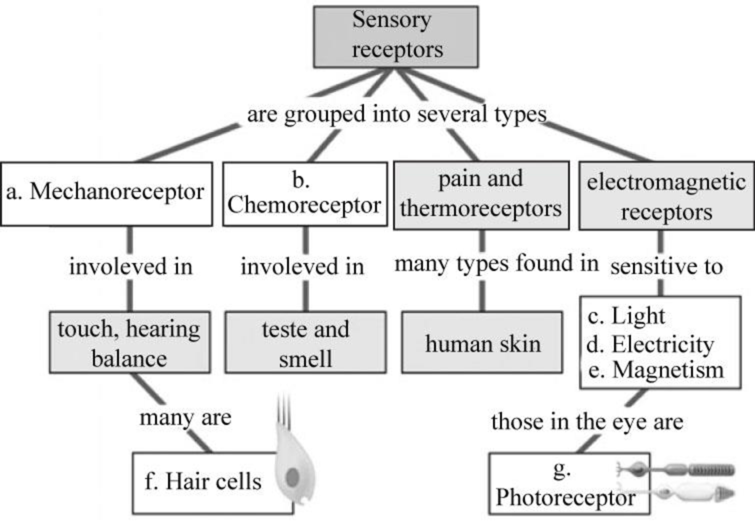
Concept explainers
To label: The sensory receptor that receives stimuli from the environment and also list the responses they show in respect to stimuli.
Concept introduction:
Sensory receptors are the structures that send stimuli to brain after receiving it in response to changes in the environment. They convey the signal to neurons from the external or internal body. Sensory receptors are present on sensory organs, namely, eyes, skin, and ear.
Explanation of Solution
Pictorial representation:
Fig.1 shows the types of sensory receptors present in humans and responses they generate.

Fig.1: Shows the type of sensory receptors and their responses.
(a)
Correct answer: Mechanoreceptor.
Plasma membrane contains a mechanogated ion channel that opens or closes in response to the stimuli. When there is a pressure applied on the membrane by stretching or twisting, the channels get activated. For example, the tympanic wall present in the ear has a mechanogated ion channel, and it helps in hearing by transmission of sound vibration. Hence, the correct answer is mechanoreceptors.
(b)
Correct answer: Chemoreceptor.
Chemoreceptors have an autonomic control, and they get stimulated by the change in the chemical concentration in the environment. Generally, they are found in the nose and mouth. Hence, the correct answer is chemoreceptors.
(c)
Correct answer: Light.
(d)
Correct answer: Electricity.
Some organisms have the ability to detect electrical energy; their electroreceptors receive the stimulus and send it to the brain for detection. For example, sharks can detect electricity that is generated by any muscular activity. Hence, the correct answer is electricity.
(e)
Correct answer: Magnetism.
Electromagnetic receptors sense the magnetic field in the environment. Birds use the magnetic field of the Earth in navigation when they migrate. Hence, the correct answer is magnetism.
(f)
Correct answer: Hair cells.
Hair cells have mechanoreceptors that generate an electrical stimulus upon stretching or when the cell feels any pressure; for example, hair cells present in the ear have receptors that detect head movement and sound. Hence, the correct answer is hair cells.
(g)
Correct answer: Photoreceptor.
Photoreceptors are present in the retina of the eye and receive the stimulus from light. Photoreceptors convert light into electric signal and send it to the brain for visual transduction. Hence, the correct answer is photoreceptor.
Want to see more full solutions like this?
Chapter 29 Solutions
Campbell Biology: Concepts & Connections (9th Edition)
- What is behavioral adaptarrow_forward22. Which of the following mutant proteins is expected to have a dominant negative effect when over- expressed in normal cells? a. mutant PI3-kinase that lacks the SH2 domain but retains the kinase function b. mutant Grb2 protein that cannot bind to RTK c. mutant RTK that lacks the extracellular domain d. mutant PDK that has the PH domain but lost the kinase function e. all of the abovearrow_forwardWhat is the label ?arrow_forward
- Can you described the image? Can you explain the question as well their answer and how to get to an answer to an problem like this?arrow_forwardglg 112 mid unit assignment Identifying melting processesarrow_forwardGive only the mode of inheritance consistent with all three pedigrees and only two reasons that support this, nothing more, (it shouldn't take too long)arrow_forward
- Oarrow_forwardDescribe the principle of homeostasis.arrow_forwardExplain how the hormones of the glands listed below travel around the body to target organs and tissues : Pituitary gland Hypothalamus Thyroid Parathyroid Adrenal Pineal Pancreas(islets of langerhans) Gonads (testes and ovaries) Placentaarrow_forward
 Human Anatomy & Physiology (11th Edition)BiologyISBN:9780134580999Author:Elaine N. Marieb, Katja N. HoehnPublisher:PEARSON
Human Anatomy & Physiology (11th Edition)BiologyISBN:9780134580999Author:Elaine N. Marieb, Katja N. HoehnPublisher:PEARSON Biology 2eBiologyISBN:9781947172517Author:Matthew Douglas, Jung Choi, Mary Ann ClarkPublisher:OpenStax
Biology 2eBiologyISBN:9781947172517Author:Matthew Douglas, Jung Choi, Mary Ann ClarkPublisher:OpenStax Anatomy & PhysiologyBiologyISBN:9781259398629Author:McKinley, Michael P., O'loughlin, Valerie Dean, Bidle, Theresa StouterPublisher:Mcgraw Hill Education,
Anatomy & PhysiologyBiologyISBN:9781259398629Author:McKinley, Michael P., O'loughlin, Valerie Dean, Bidle, Theresa StouterPublisher:Mcgraw Hill Education, Molecular Biology of the Cell (Sixth Edition)BiologyISBN:9780815344322Author:Bruce Alberts, Alexander D. Johnson, Julian Lewis, David Morgan, Martin Raff, Keith Roberts, Peter WalterPublisher:W. W. Norton & Company
Molecular Biology of the Cell (Sixth Edition)BiologyISBN:9780815344322Author:Bruce Alberts, Alexander D. Johnson, Julian Lewis, David Morgan, Martin Raff, Keith Roberts, Peter WalterPublisher:W. W. Norton & Company Laboratory Manual For Human Anatomy & PhysiologyBiologyISBN:9781260159363Author:Martin, Terry R., Prentice-craver, CynthiaPublisher:McGraw-Hill Publishing Co.
Laboratory Manual For Human Anatomy & PhysiologyBiologyISBN:9781260159363Author:Martin, Terry R., Prentice-craver, CynthiaPublisher:McGraw-Hill Publishing Co. Inquiry Into Life (16th Edition)BiologyISBN:9781260231700Author:Sylvia S. Mader, Michael WindelspechtPublisher:McGraw Hill Education
Inquiry Into Life (16th Edition)BiologyISBN:9781260231700Author:Sylvia S. Mader, Michael WindelspechtPublisher:McGraw Hill Education





